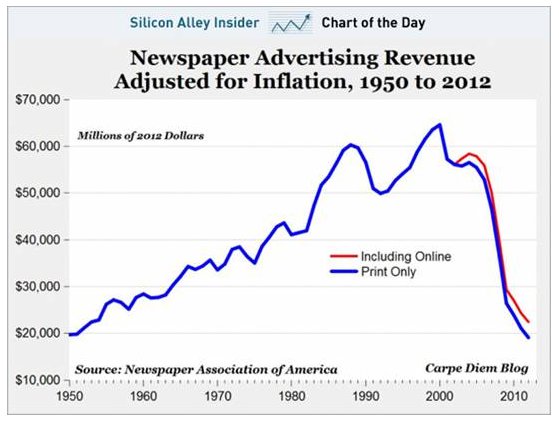As you will know, dear reader, I made a career change earlier this year, to work for a local business news media organisation. Looking at the chart above, you may wonder why!
I’m absolutely loving it. The attraction of the position was to be front and centre of a major shift in how media companies arrange themselves, operate, what they stand for, how they are to be viable (in some cases, simply surviving would be a feat) and how they plot their future. Could we protect journalism as a profession, or is it doomed? What business model would/could work for media?
Today, we hear the Business Review Weekly (BRW) is to close its weekly print publication. The oldest newspaper in the world (Lloyd’s List) closed last month (read story). It began in 1723. It has 16k+ paying subscribers though and has simply turned off the paper. All digital. In the UK, AutoTrader did similar earlier this year. All digital.
In Australia, News Corps’ latest figures show:
- their paper revenues fell by 15% (or $350mn) last year
- write down of paper assets of $1.4bn
- News’ falls are even worse than Fairfax’s, who fell $120mn (-5%)
- Fairfax are cutting more jobs – mainly in the business sections
This is just a shift, albeit a major one. Like all great shifts (the ageing process, climate change…) it happens fairly slowly, and yet inexorably. You can get away with ignoring it for a few years but the more you wait, the higher the cost of fixing it becomes. I’ve been inside one of these shifts before and ridden it out the other side.
I am excited to be in the middle of it because no one has got this nailed yet. I do believe the company I am in has a well thought out strategy, is executing on it patiently, and it’s working. I also think print and traditional sales will continue for a while yet. As Supertramp once said, “Crisis? What Crisis?”
1/3 rd of US papers are now behind paywalls. Traffic initially fell, but most have made it all back again, and have a new connection with their paying subscribers, who are happy to pay for quality content. A year ago a survey showed 3% of people would pay for paywall content, today that has jumped to 9%. Slow, inexorable shifts. The trend is your friend. Time will tell.



